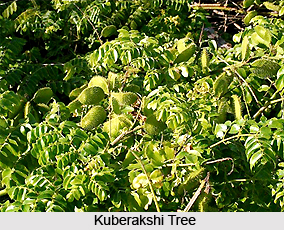 Kuberakshi is one of the plants that have ample medicinal values. This plant is also known as `natakaranja` in Bengali, physic nut in English, `gatan` in Hindi, `kotokoleja` in Oriya, and `kuberakshi` in Sanskrit. The botanical name of this plant is Caesalpinia bonduc.
Kuberakshi is one of the plants that have ample medicinal values. This plant is also known as `natakaranja` in Bengali, physic nut in English, `gatan` in Hindi, `kotokoleja` in Oriya, and `kuberakshi` in Sanskrit. The botanical name of this plant is Caesalpinia bonduc.
Kuberakshi is a large, prickly, prostrate or climbing, evergreen shrub that is up to 20 metre tall. Branchlets are finely grey-downy, armed with hooked and straight hard yellow prickles. Leaves are alternate, bipinnate, leaflets are membranous, ellipticoblong, and petioles are prickly. Flowers are yellow, fragrant, borne in axillary and petals are oblanceolate and yellow. Fruits are somewhat swollen, oblong, prickly, dark brown to black in colour. This plant bears flowers from August to November and fruits from December to February in central India.
Kuberakshi is a pantropical species, found wild throughout the plains of India and up to an altitude of 850 metre in hedges and on wastelands near villages. Also found in the lowland alluvial, particularly coastal, regions of western, eastern and southern India. This plant is commonly cultivated as a hedge plant.
Apart from these, this plant has some medicinal properties and uses. Kuberakshi or
Bonduc nuts have long been used as an antiperiodic in traditional Indian medicine. They also possess diuretic and antipyretic activity, and are used in Ayurveda for treating diarrhoea, intestinal worms, hydrocele, anasarca, liver and spleen diseases, diabetes, leprosy and piles. The seeds have a bitter taste, are valued in traditional medicine as a tonic, and are recommended for treating fever, asthma and colic. They are an ingredient of several Ayurvedic preparations, including Avush-64, used as an anti-malarial drug. Made into an ointment, they are used to treat hydrocele. As an infusion, they are used to treat cerebral haemorrhage and infantile convulsions. A paste prepared from the seeds is applied externally to treat hydrocele among the Irulars in Tamil Nadu and to promote healing of boils among the inhabitants of Bhadrak District in Orissa. Mixed with oil, the pounded seed kernels are used to relieve body-ache among the tribal inhabitants of Surguja District in northeastern Madhya Pradesh. The seeds are reported to be abortifacient. In Jammu and Kashmir, the plant juice is prescribed after meals for 2 weeks to treat intermittent fever. In some other places, the plant is used in traditional medicine for the treatment of skeletal fractures. The seed oil is emollient and used for stopping discharge from the ear, for removing facial freckles and for treating skin diseases; it is also antirheumatic and compares favourably with phenylbutazone. The tender leaves are used to treat liver disorders; boiled with castor oil or butter fat, they are applied externally to relieve painful and swollen testicles. The leaves and bark are emmenagogue, anthelmintic and febrifuge. The leaves are used in the treatment of piles, worms and oedema. A decoction of the root is used to treat bladder stones; mixed with honey, the root is used to cure leucorrhoea.
Kuberakshi is a medicinal plant and for the medicinal usage, it is reckoned in India and also in several other parts of the world.



















